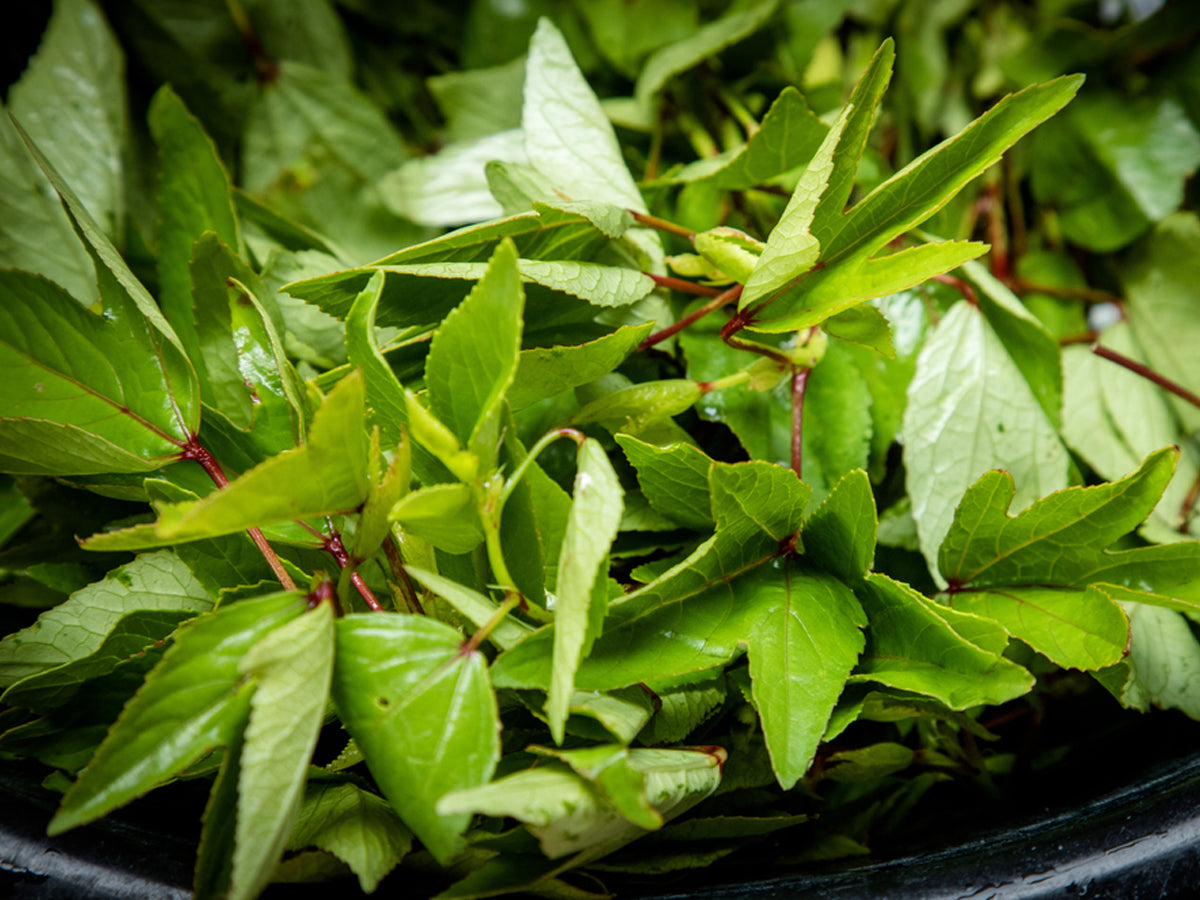How to Grow
Everything You Need to Know about Growing Gongura Leaves at Home
Are you looking to add a pop of flavour and a touch of the exotic to your garden? Look no further than gongura! This unique green, also known as sorrel or red-stemmed hibiscus, is making a name for itself with its tangy, slightly sour taste, a staple in South Asian cuisine.
But why settle for just eating it when you can grow it yourself? Not only is growing gongura a fun and satisfying experience, but it also brings a taste to your very own backyard.
So whether you're an experienced green thumb or just starting, let's dive into everything you need to know about growing gongura at home. From the best soil conditions to optimal watering techniques, we've got you covered.
Start growing gongura at home today and enjoy the many benefits it has to offer. From its health benefits to its versatile use in the kitchen, this excellent herb is a must-have for any home gardener or foodie. So, gather your gardening tools and let's dive into it further.
In this article, we will learn about the following:
- Facts About Gongura Plant
- Benefits of Growing Gongura At Home
- How To Grow Gongura Plant At Home
- How To Take Care of Gongura Plant
Facts about Gongura Plant
- Gongura in English name, also known as sorrel or hibiscus sabdariffa, is a plant widely grown in tropical regions. It is a fast-growing, annual plant that belongs to the family Roselle.
- It is known for its tangy leaves used in various culinary dishes. It is a nutritious plant that provides a good source of vitamins, minerals, and antioxidants.
- Gongura is a tropical plant that grows up to 6-8 feet tall. It has large, serrated green leaves with a slightly rough texture.
- The flowers of the gongura plant are small and pink and grow in clusters. The plant produces fleshy, red, and juicy calyces, the modified sepals of the gongura flowers used in cooking.
- The gongura plant leaves are edible and used in various dishes in different regions. They are cooked and used as a side dish or added to soups and stews. The leaves have a tangy, sour taste that many people love.
- Gongura is believed to have medicinal properties and is used in traditional medicine to treat various ailments. It is said to have anti-inflammatory and antioxidant effects, be used as a diuretic, and aid digestion. Some people use gongura to treat skin conditions, fever, and headaches.
- Gongura comes in two main varieties: green-leaved and red-leaved. The green-leaved variety is more commonly used in cooking, while the red-leaved variety is used primarily for its ornamental value. The red-leaved variety is also believed to have a slightly milder taste than the green-leaved variety.
Benefits of Growing Gongura at Home
Growing gongura at home is a fantastic way to add green to your surroundings while reaping several health benefits. This article will explore the exciting gongura benefits.
Nutritional Benefits
Gongura leaves are a rich source of vitamins and minerals such as Vitamin C, iron, calcium, and potassium. These leaves can be used in salads, soups, and even as a spice in curries. Gongura leaves in English are known for their tangy and slightly bitter taste, adding flavour to any dish.
Aids in Digestion
Gongura is known for its digestive properties and is often used in traditional Indian medicine for digestive issues such as acidity, constipation, and indigestion. Gongura leaves can help regulate the digestive system, keeping the gut healthy and preventing digestive problems.
Anti-Inflammatory Properties
Gongura contains anti-inflammatory properties that can help relieve pain and swelling caused by arthritis, gout, and other inflammatory conditions. It can also help reduce redness and itching associated with skin conditions like eczema and psoriasis.
Boosts the Immune System
Gongura is an excellent vitamin C source, essential for a healthy immune system. Vitamin C stimulates the production of white blood cells, which help fight infections and diseases.
Promotes Healthy Skin
Gongura is rich in antioxidants, which help to prevent skin damage caused by free radicals. Antioxidants can also help slow ageing, keeping the skin looking young and fresh.
Environmentally Friendly
Growing gongura at home is a great way to contribute to a greener environment. Unlike store-bought greens, home-grown gongura does not require transportation, packaging or preservatives, reducing carbon footprint and promoting sustainability.
Cost-Effective
Growing gongura at home is a cost-effective way to get fresh greens. The cost of buying a gongura plant is small compared to buying its leaves from the market. Additionally, once the plant is established, it will produce leaves for a long time, reducing the cost even further.
Stress Relief
Gardening is a great way to relieve stress and calm the mind. It provides a sense of accomplishment and helps to connect with nature. Growing gongura at home can provide a sense of peace and relaxation, helping to reduce stress and anxiety.
How to Grow Gongura Plant at Home
Gongura is easy to grow and can be propagated from seeds or cuttings. This article will discuss how to grow the gongura plant at home from seeds and cuttings.
Materials
- Gongura seeds or cuttings
- Potting mix or garden soil
- Container or garden bed
- Watering can or hose
- Fertiliser (optional)
Propagation from Seeds
- Choose a container with proper drainage holes and fill it with a quality potting mix or garden soil.
- Sow gongura seeds about ½ inch deep and 36 inches apart in the soil.
- Water the seeds thoroughly and cover the container with plastic wrap to maintain moisture and warmth.
- Place the container in a warm, bright location and remove the plastic wrap once seedlings emerge.
- Once seedlings are 2-3 inches tall, thin them out to about 60 inches apart.
- Water the seedlings regularly and provide them with adequate sunlight.
Propagation from Cuttings
- Choose a healthy gongura plant to take cuttings from.
- Cut a stem about 4-6 inches long and remove the leaves from the bottom half.
- Dip the cut end in rooting hormone and plant it in a potting mix or garden soil container.
- Water the cutting and cover it with a plastic bag to maintain moisture.
- Place the container in a bright, warm location and remove the plastic bag once roots have formed and new growth appears.
- Transplant the rooted cutting into a larger container or garden bed.
How to Take Care of Gongura Plant:
Soil
Gongura plants prefer well-drained soil with a pH of 5.5 - 6.8. The soil should be moist but not soggy. If your soil is heavy and clay-like, you can add compost, peat moss, or sand to improve drainage. You can also grow gongura in pots, but use a high-quality potting mix that drains well.
Sunlight
Gongura plants prefer full sun but can tolerate partial shade. They need at least six hours of direct sunlight every day. In hot climates, it's best to provide some shade during the hottest part of the day to protect the leaves from sunburn.
Location
Gongura plants are hardy and can be grown in various locations, from your kitchen windowsill to your garden. Choose a location that receives plenty of sunlight but avoid areas prone to strong winds, as the wind can damage the leaves.
Temperature
Gongura plants prefer warm temperatures between 23-29°C.
Fertiliser
Gongura plants benefit from regular fertilisation with a balanced, water-soluble fertiliser. Apply fertiliser every two weeks during the growing season, but avoid over-fertilizing, as too much fertiliser can lead to yellowing and stunted growth of gongura leaf in English.
Water
Gongura plants prefer moist soil, but they don't like to be waterlogged. Water your plant regularly, but be careful not to overwater, as this can lead to root rot. Make sure the soil has time to dry out between waterings and be especially careful during hot, dry weather, as the plant may need to be watered more frequently.
Pruning
Pruning is essential for keeping gongura plants healthy and producing plenty of leaves. Prune back the plant by about one-third after each harvest to encourage new growth. If your plant becomes too tall, you can prune it back by half to control its size.
Mulching
Mulching is essential for keeping the soil moist and preventing weed growth. Spread a 2-3 inch layer of mulch around the base of your gongura plant to help keep the soil moist and prevent weed growth. Avoid using too heavy mulch, which can lead to waterlogged soil and root rot.
Always be patient and attentive to your gongura plant's needs, and you'll be rewarded with a healthy and delicious herb that adds a unique taste to your cooking.
Conclusion
Just remember to be patient and attentive to your plant's needs, and you'll be rewarded with a healthy and delicious herb that adds a tangy flavour to your meals. So, go ahead, grab a few seeds, and start growing! You never know; you might fall in love with this amazing plant and make it a staple in your kitchen garden. Happy gardening!
FAQs on Gongura Plant
Q. What is the best time to grow a gongura plant?
The best time to grow the gongura plant is during the warm and wet growing season, typically from late spring to early fall in tropical regions. However, they can be grown around the year, except for frost.
Q. What are the pests and diseases that affect gongura plants?
Common pests that can damage gongura plants include aphids. Diseases that can affect gongura include powdery mildew and leaf spot.
Q. How often should I spray insecticidal soap or neem oil on my gongura plant?
The application frequency depends on the pest infestation's severity and the type of control method used. As a general rule, it is recommended to spray insecticidal soap or neem oil once every 7 to 10 days until the pests are no longer present.
Q. Can gongura be eaten raw?
Yes, gongura leaves can be eaten raw, though they are more commonly used in dishes like stews, curries, and chutneys. When eaten raw, gongura leaves have a tangy, sour flavour that can be pretty strong. Some people enjoy eating gongura raw as a side dish, while others prefer to cook it to reduce the sourness.



